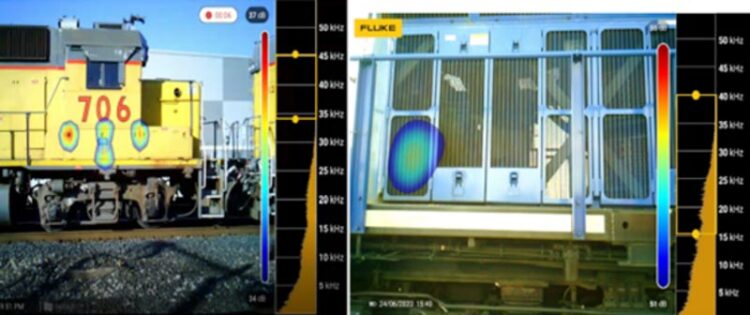Automated system to detect compressed air leaks on trains

SwRI developed an automated compressed air leak detection system that can acoustically and visually detect and report air leaks on moving trains, indicated by spectral signatures in the photos. The team tested the proof-of-concept system on rail cars and trains at SwRI’s Locomotive Technology Center in San Antonio.
Credit: Southwest Research Institute
Technology could help industry save millions in fuel consumption, reduce exhaust emissions.
Southwest Research Institute (SwRI) has developed a proof-of-concept system to autonomously detect compressed air leaks on trains and relay the location of the leaks to mechanical personnel for repair. The automated system could reduce the time, costs and labor needed to find and repair air leaks, and it could lower the locomotive industry’s overall fuel consumption and exhaust emissions.
Trains use compressed air for a variety of functions, including air brakes, valve actuation, radiator shutters, horns and bells. Each year it is estimated that the rail industry loses between 2-3% vehicle efficiency due to air leaks that occur at various points throughout trains. Additionally, these leaks can have a detrimental effect on train operability and safety.
“Air leaks significantly increase fuel consumption and reduce the effectiveness of a locomotive’s automatic engine stop-start (AESS) systems, which causes locomotives to run more often, burn more fuel and reduces the lifespan of parts such as starters, air compressors and batteries,” said SwRI Lead Engineer Christopher Stoos. “We are talking potentially saving millions of gallons of fuel and reducing carbon dioxide, oxides of nitrogen and particulate matter emissions.”
Currently, finding air leaks requires railroad employees to manually search for them, often going on, under or between railway vehicles to listen or feel for leaks. The practice is inefficient, time-consuming and introduces unnecessary risk to mechanical staff. Knowing this, the Federal Railroad Administration and railroads have outlined acceptable air leak rates for trains.
To significantly reduce these leaks, SwRI has created a system that uses audio detection technology, cameras and machine learning to autonomously detect, identify and report air leaks, even on moving trains.
The project is funded by the Transportation Research Board’s (TRB) Rail Safety IDEA program and led by Stoos, Senior Research Engineer Heath Spidle and Research Engineer Jake A. Janssen.
The system uses a small, commercially available Fluke SV600 fixed acoustic imager that uses a 64-microphone array and camera tuned to detect frequencies of 30-45kHz, the frequencies at which compressed air leaks best stand out from most background noise. This instrument works in concert with a secondary visual spectrum camera. To automate the detection process, the team trained and implemented machine learning algorithms to identify air leaks from the sensor outputs while ignoring non-leak related outputs.
During testing, the prototype system successfully detected a range of air leaks at various locations on locomotives with a false positive rate of only 0.03%. The system detected, on average, 11 out of every 13 leaks on a moving train. Once an air leak was identified, an alert with an accompanying image was shared electronically with appropriate personnel showing the area in need of inspection and repairs.
“The system should reduce the burden on mechanical personnel and improve the compressed air system’s performance,” said Stoos. “Further field development and testing is still necessary, but this system could potentially save the locomotive industry millions in fuels savings and maintenance if implemented correctly. This technology could also greatly reduce greenhouse gas emissions by improving locomotive fuel efficiency.”
The SwRI team shared a presentation detailing the development of the system and their findings, titled Autonomous Detection of Compressed Air Leaks on Trains, at the 2022 Rail Supply Institute’s Expo & Technical Conference in Fort Worth, during the Locomotive Maintenance Officers Association’s annual program.
For more information, visit https://www.swri.org/industries/locomotive.
Media Contacts
Darlene Herring
Southwest Research Institute
darlene.herring@swri.org
Office: 210-522-5692
Jesus Chavez
Southwest Research Institute
jchavez@swri.org
Office: 210-522-2258
All latest news from the category: Transportation and Logistics
This field deals with all spatial and time-related activities involved in bridging the gap between goods and people, including their restructuring. This begins with the supplier and follows each stage of the operational value chain to product delivery and concludes with product disposal and recycling.
innovations-report provides informative reports and articles on such topics as traffic telematics, toll collection, traffic management systems, route planning, high-speed rail (Transrapid), traffic infrastructures, air safety, transport technologies, transport logistics, production logistics and mobility.
Newest articles
Faster, more energy-efficient way to manufacture an industrially important chemical
Zirconium combined with silicon nitride enhances the conversion of propane — present in natural gas — needed to create in-demand plastic, polypropylene. Polypropylene is a common type of plastic found…

Energy planning in Ghana as a role model for the world
Improving the resilience of energy systems in the Global South. What criteria should we use to better plan for resilient energy systems? How do socio-economic, technical and climate change related…

Artificial blood vessels could improve heart bypass outcomes
Artificial blood vessels could improve heart bypass outcomes. 3D-printed blood vessels, which closely mimic the properties of human veins, could transform the treatment of cardiovascular diseases. Strong, flexible, gel-like tubes…





















